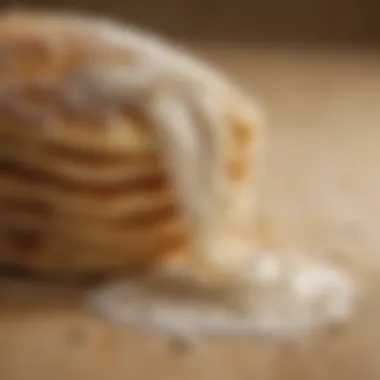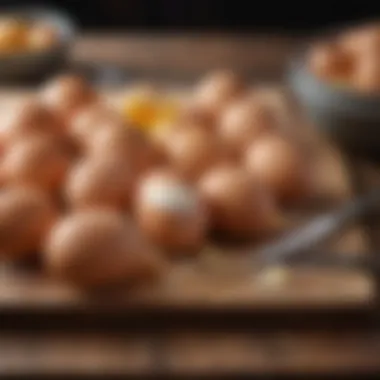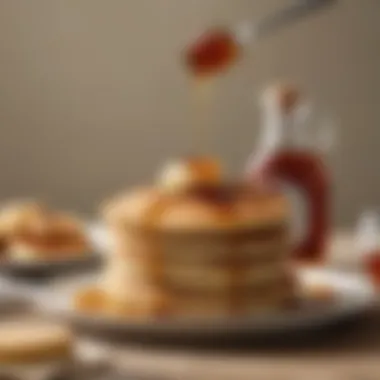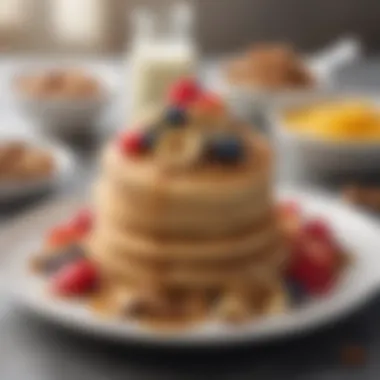Essential Ingredients for Homemade Pancakes: A Guide


Intro
Creating homemade pancakes is not just about filling your stomach; it’s about the experience of mixing simple ingredients to form a delightful breakfast classic. To achieve the best results in pancake-making, one must understand the essential ingredients involved. Every human wants efficiency in the kitchen, especially when they are busy, and a well-structured pancake recipe fits perfectly into a hectic daily routine.
This guide is tailored to both seasoned cooks and those who possess minimal experience. It aims to dissect the role each ingredient plays in the process and emphasizes the functional aspects over mere flavor. By analayzing what pancakes need, incorporating tips for substitutions, and expanding cooking methods, we hope to provide practical advice for anyone looking to create homemade classics sustainably and tastefully.
Now, let's begin this culinary journey.
Recipe Highlight
Classic Buttermilk Pancakes
These timeless pancakes are light, fluffy, and can make any morning special.
Essential Ingredients:
- All-purpose flour
- Buttermilk
- Eggs
- Baking powder
- Sugar
- Salt
- Melted butter
Estimated Prep Time: 15 minutes
Estimated Cook Time: 10-15 minutes
Servings: About 4 servings
Step-by-Step Instructions
- Combine the Dry Ingredients: In a large bowl, whisk together the flour, baking powder, sugar, and salt. Making sure there are no lumps is crucial for uniform mixing.
- Mix Wet Ingredients Separately: In another bowl, beat the eggs, then add buttermilk and finally mix in melted butter. Stir till everything is incorporated but do not overmix.
- Integrate the Mixtures: Form a well in the center of the dry ingredients, pour in the wet mixture, and stir just until combined. The batter should remain slightly lumpy.
- Cooking the Pancakes: Preheat a non-stick skillet over medium heat and use a light coating of oil or butter. Pour ladlefuls of batter onto the hot surface.
- Finishing Up: Cook until bubbles form on the surface, then flip the pancakes and cook for an additional 2-3 minutes until golden brown.
Insider Tip: Avoid over-mixing, as this will lead to tough pancakes. Keep also an eye on your heat; too high may burn while too low delays cooking.
Variations and Substitutions
To cater to different tastes or dietary requirements, consider these options:
- Flour Substitutes: If gluten-free, use a mix of almond flour and gluten-free all-purpose flour.
- Milk Alternatives: Almond milk or coconut milk can function as good substitutes for buttermilk.
- Flavor Enhancements: Consider adding vanilla extract, cinnamon, or even chocolate chips for extra flair.
Pancakes can also be served with diverse toppings like maple syrup, sliced fruit, or yogurt to elevate texture and taste.
Time-Saving Cooking Tips
- Preparation is Key: Measure flour in advance and store in an airtight container. Similarly, you can sift dry ingredients in bulk.
- Use Kitchen Gadgets: A non-stick electric griddle might allows you to cook more pancakes at once, saving time.
- Meal Prep: Pancake batter can be made the night before and stored in the refrigerater. Just give it a gentle stir before use.
Nutritional Information
A serving of these classic buttermilk pancakes contains approximately 220 calories. Significant nutritional components include:
- Carbohydrates: Mainly from flour and sugar.
- Protein: Largely from the eggs and buttermilk.
- Fats: Provided by butter.
These pancakes can fit into various dietary plans. For instance, they can become gluten-free and dairy-free with proper substitutions, making them accessible for diverse group preferences.
Prologue to Pancake Making
Pancakes are a beloved comfort food that transcends borders and cultures. Understanding the fundamentals of pancake making not only enriches culinary skills but also enhances the overall experience of cooking. This part of the guide emphasizes how mastering pancakes begins with recognizing their essential ingredients. Each component contributes distinctively to the texture, flavor, and nutritional value of the final dish.
Preparing pancakes at home holds several advantages. First and foremost, it allows for customization according to individual tastes and dietary restrictions. Whether someone is gluten intolerant, looking for vegan options, or prefers a specific flavor profile, the ingredients can easily be adapted.
Furthermore, understanding pancake basics fosters efficiency in the kitchen. Knowing which ingredients are core and which are optional helps streamline the cooking process. This guide delves into each mentioning elements such as flour, egg, and milk and explains their roles in achieving light, fluffy pancakes or dense versions if desired.
"The beauty of homemade pancakes lies in their adaptability. Substitute ingredients creatively to reinvent traditional recipes."
In summary, having a solid grasp of pancake making contributes significantly to culinary competence. It is more than simply following a recipe; it is about recognizing the importance of each element. Mastery over these skills not only saves time for busy people but also allows for lovely moments shared around the table with family and friends. This section sets the stage for connecting with the various types of pancakes that can be created and how the right ingredients ensure success.


Core Ingredients for Pancakes
Understanding the core ingredients for pancakes is essential for anyone interested in mastering this culinary classic. Each ingredient serves a specific purpose and contributes to the overall texture and flavor. Keeping this in mind ensures that every batch is not only enjoyable but also makes the cooking process more efficient.
Flour
Types of Flour
When selecting flour, the type you choose can significantly affect the outcome of your pancakes. All-purpose flour, for instance, is the most common choice. Its balance of protein provides good structure and texture. Conversely, whole wheat flour brings additional fiber and a nutty flavor, which may appeal to some health-conscious individuals.
Advantages of All-Purpose Flour:
- Readily available
- Creates lightweight and fluffy pancakes
- Well-balanced for various pancake styles
Disadvantages of Whole Wheat Flour:
- Can produce denser pancakes
- May require additional liquid or adjustments to keep the mixture cohesive
Gluten-Free Alternatives
Gluten-free alternatives, like almond flour or oat flour, allow those with dietary restrictions to enjoy pancakes too. These options can deliver unique flavors but might require special handling. For example, almond flour tends to yield a crumblier texture compared to medium strength flours.
Key Characteristic:
- Offers a fruitier, earthier taste.
Unique Features:
- Requires less than wheat flour in terms of volume due to its density.
Baking Powder
Function and Importance
Baking powder is pivotal in pancake recipes, as it acts as a leavening agent. It creates the characteristic fluffiness by generating carbon dioxide bubbles when mixed with wet ingredients. This critical function makes pancakes rise while cooking. If improperly used, the texture might become heavy, trifurcating the batter's integrity.
Why Baking Powder is Beneficial:
- Provides immediate chemical reaction, crucial for successful pancakes.
Substitutions for Baking Powder
You can create a substitute for baking powder by mixing cream of tartar and baking soda. A ratio of two parts cream of tartar to one part baking soda can accomplish a comparable effect in the batter. Another viable substitute is using yeast, offering a different flavor profile and texture altogether. But this change in ingredients sometimes extends cooking time as yeast requires time to rise.
Unique Feature:
- Allows flexibility when exploring potentials of different recipes.
Eggs
Role of Eggs in Pancakes
Eggs play a vital role in pancake recipes. They are responsible for binding all ingredients while adding moisture and richness to the batter. The protein in eggs helps in giving structure, keeping the pancakes from falling apart during flipping.
Advantages of Eggs:


- Results in a fluffy and rich pancake
- Contributes to browning due to Maillard reaction when cooking
Egg-Free Options
For those looking to avoid eggs, options include using applesauce or flaxseed meal as substitutes. Applesauce contributes moisture, while flaxseed meal creates a similar binding effect. Though these alternatives may alter flavor slightly, they provide another dimension and are good for health-conscious cooks.
Unique Features of Egg-Free Options:
- Each ingredient lends its own characteristic taste depending on choice.
Milk
Types of Milk to Use
Different varieties of milk, such as whole, skim, and buttermilk, each bring a unique taste to pancakes. Whole milk yields richer pancakes, while buttermilk contributes acidity, creating tenderness. The fat content affects how proteins interact, ensuring structure-to-le季.【15】
Dairy-Free Alternatives
With an increase in plant-based diets, alternatives like almond milk or soy milk become popular. Both alternatives offer unique flavors, allowing creativity in pancake-making. Using nut milk, for instance, adds flavor while keeping it light.
Sugar
Sweetening Alternatives
While granulated sugar is conventional, options like maple syrup or applesauce can also sweeten pancakes. Maple syrup adds a distinctive flavor, altering the overall profile positively. Utilizing honey or agave nectar is another means of diversifying the recipe further.
The Impact of Sugar on Pancake Flavor
Sugar contributes not just sweetness; it enhances browning's chemical reactions during cooking. Depending on the sugar's type galvanizes flavor depth, lending catches noticeable notes depending how significantly it contributes to the pancake's development, adding complexity to an otherwise simple dish.
Butter
Using Butter for Flavor
Butter is an irreplaceable classic showstopper when enhancing pancakes. The richness it brings drives flavor and retains moisture in the resulting dish. Some prefer clarifying butter to emphasize these aspects even further.Place emphasizing but not too cloyingly sweet.
Options for Oil Substitution
When caster sugar caters, neutral oils like vegetable oil make those essentials both convenient and simple. Although some might seek flavor enhancement options like coconut or olive oil. They're more beneficial for distinct flavor restoration attempts useful in different recipes.
Remember: Each ingredient plays a valuable role in achieving the best pancake. Knowing their purpose influences quality and overall cooking experience while preparing this delightful breakfast item.
Optional Ingredients and Variations
Optional ingredients and variations play a significant role in elevating homemade pancakes beyond the basic recipe. These components give cooks the flexibility to personalize their pancake experience. A variety of options allows for creativity, catering to diverse preferences and dietary needs. By integrating add-ins and selecting the right toppings, you can significantly enhance flavor and texture while still maintaining the simplicity of pancake making.
Add-ins for Flavor
Fruits and Nuts
Adding fruits and nuts contributes both flavor and texture to pancakes. Common fruits include berries, bananas, or apples. These fruits not only enhance the sweetness but also provide moisture. Nuts like walnuts or pecans add a pleasing crunch as well as healthy fats, bringing additional nutritional benefits to your meal. Incorporating fruits can be beneficial as they impart natural sugars and moisture, resulting in a fluffier pancake. The main consideration is how to balance the wet fruits with the dry pancake mixture. Too much moisture from fruits can lead to pancakes that are not fluffy.
Spices and Extracts
Incorporating spices and extracts adds depth to the flavor profile of pancakes. Options like vanilla extract, cinnamon, and nutmeg can elevate standard pancakes into a gourmet dish. For instance, vanilla extract contributes a warm, sweet aroma. Cinnamon and nutmeg introduce earthy tones that can transform a simple meal. The great benefit of using spices is their ability to enhance flavor without adding calories. However, it's important to measure carefully since strong spices have the potential to overwhelm the pancake mix.


Toppings
Common Pancake Toppings
Common pancake toppings include syrup, whipped cream, or fruit preserves. Maple syrup is a classic choice, offering a natural sweetness that pairs well with pancakes. Whipped cream adds richness and an enjoyable texture. Fruit preserves provide a tangy element, balancing the sweetness of pancakes nicely. These toppings enrich both flavor and presentation and can be varied according to individual taste preferences. However, opting for high-sugar toppings may counteract some health benefits of pancakes. Moderation is key.
Healthy Topping Alternatives
For those looking for healthy options, alternatives like Greek yogurt, fresh fruits, or nut butters can be excellent choices. Greek yogurt adds creaminess along with protein, enhancing nutritional value. Fresh fruits contribute natural sweetness and nutrients without added sugars. Nut butters offer healthy fats and flavor while creating a satisfying meal. Nonetheless, while these health-focused toppings are nutritious, one must consider portion sizes to ensure overall balance with the pancakes themselves.
The inclusion of optional ingredients provides a way to customize homemade pancakes, making each meal a unique experience.
Essential Cooking Equipment
Understanding the right cooking equipment is crucial for anyone looking to create the perfect pancakes. An efficient setup not only facilitates the cooking process but also influences the final result. Selecting the right equipment means achieving better texture, flavor, and overall enjoyment in pancake making. This section will delve into the essential items that assist in crafting delicious pancakes, informing you why specific choices directly affect your cooking experience.
Mixing Bowls and Utensils
Mixing bowls and tools are foundational components in any kitchen. They facilitate the correct blending of ingredients, which impacts the pancake's texture substantially. It’s recommendable to choose bowls made from materials that can handle various temperatures and are easy to clean.
Some key characteristics of mixing bowls include:
- Size: A larger bowl provides ample space for whipping and mixing without creating mess.
- Material: Glass and stainless-steel utensils are long-lasting and offer easier cleaning options.
Utensils, such as whisks and spatulas, are vital in achieving the desired smooth consistency in your batter. A spring-loaded spatula can be beneficial for flipping pancakes with precision.
Cooking Surfaces
The choice of cooking surface plays a notable role in pancake preparation as it determines heat distribution and cooking time. Skillets and griddles are the primary cooking surfaces used, and each brings its strengths.
Skillets versus Griddles
Skillets are versatile and commonly used tools in many kitchens. Their characteristic smooth surface distributed heat evenly, set the foundation for great pancake making. Skillets usually have high sides, which make it easy to flip and manage the batter.
On the other hand, griddles have a larger, flat cooking surface, allowing for the preparation of multiple pancakes simultaneously. This feature makes them a popular choice when cooking for larger groups, reducing overall cooking time. The larger area enables a consistent cook throughout, producing evenly browned pancakes without needing to flip them frequently.
Non-Stick Versus Traditional Cookware
Non-stick cookware simplifies the pancake-making process. It reduces the likelihood of pancakes sticking to the surface, making flipping and serving easier. The ease of cleaning is another major benefit.
However, traditional cookware presents its advantages as well. These materials often distribute heat more evenly and provide a nice caramelization effect, beneficial to achieving complex flavors in pancakes. Understanding these distinctions allows the cook to select accordingly based on their individual preferences and desired outcomes.
Cooking equipment significantly influences the texture and taste of your pancakes. Choices made in this area can enhance or inhibit your overall cooking experience.
Exploring each of these elements and adjusting them according to your settings and needs can significantly improve your pancake-making journey. Hitting the right balance of utensils ensures efficiency and inspires seamless pancake perfection.
Ending: Mastering Homemade Pancakes
Creating the perfect pancake requires understanding and skill. Throughout this article, we have explored essential ingredients and the roles each play in the pancake-making process. From selecting the right flour to understanding how eggs contribute to fluffiness, mastering these elements is pivotal for any cook, whether novice or experienced.
Pancakes offer flexibility. The techniques and substitutions discussed allow cooks to adapt recipes to fit dietary needs or personal taste. Knowing these can empower individuals to create delicious pancakes whether they follow gluten-free, dairy-free, or vegan diets. Each ingredient can transform the texture and flavor of your pancakes markedly.
Additionally, equipment choice greatly influences the end result. Using the right mixing tools and cooking surfaces significantly affects cooking time and pancake uniformity. Consider the heat distribution and surface material carefully when selecting your stove setup.
Getting the proportions right is crucial. Too much baking powder can lead to overinflated pancakes, while too little may yield flat ones.
Through learning and practice, one can master pancake-making. With the tips laid out in this article, any home cook can streamline their process while enhancing flavors. Good pancake recipes can also foster creativity, allowing room for innovations based on seasonal ingredients or personal preferences. Each batch is a chance to learn and improve.
Finally, homemade pancakes are more than just a meal; they create a warm atmosphere for family and friends. Their universal appeal unites people around breakfast tables, doing what very few dishes can accomplish. Everyone deserves the joy of delicious, properly made pancakes crafted to their liking. As your confidence in pancake-making grows, so does your culinary repertoire.
Embrace this multifaceted creature of culinary arts and enjoy the pleasures and benefits that come with it.







